Table of Contents:
- Brand and Supplier Selection
- Product Technical Specifications
- Chip and Material Quality
- Application Scenarios
- Energy Efficiency and Environmental Protection
- After-sales Service and Warranty
- Price and Cost-effectiveness
- Conclusion
1. Brand and Supplier Selection
a. Renowned Brands: Korea is home to several leading LED module manufacturers, such as Samsung and LG. When purchasing, customers are advised to prioritize these well-known brands due to their strong competitive advantages in technology development, product quality, and after-sales service. These brands typically offer stable product performance and long-lasting durability.
b. Supplier Credentials: Ensure the supplier has proper credentials and extensive experience in selling LED modules. Buyers should assess the supplier’s business scale, customer reputation, and service network. This is especially crucial for international procurement, where a comprehensive logistics and after-sales service system is critical.

2. Product Technical Specifications
a. Pixel Pitch and Resolution: Pixel pitch determines the clarity of an LED module, with smaller pitches providing higher resolution. Buyers should select the appropriate pixel pitch based on their project’s needs. For close viewing, choose modules with pitches between P1.5 and P2.5, while pitches of P4 to P10 are suitable for long-distance displays. What is a fine pitch LED display?
b. Brightness and Contrast: Brightness and contrast affect the visibility of the LED module in different lighting conditions. Choose brightness levels that suit the application scenario:
- Indoor use: 800-1500 nits.
- Outdoor use: Over 5000 nits for clear visibility in direct sunlight. Here is the knowledge about nit brightness.
c. Refresh Rate: A high refresh rate ensures smooth content display, especially for video playback. Low refresh rates may cause screen flicker. For dynamic content, it’s recommended to select LED modules with a refresh rate above 1920Hz.
d. Color Uniformity and Color Temperature: Color uniformity directly impacts display quality. Korean-made LED modules often exhibit excellent color reproduction and contrast. Select products with high-quality calibration technology to ensure consistent and vibrant colors across the screen.

3. Chip and Material Quality
a. Chip Quality: The core component of an LED module is the LED chip. Korean LED chips are known for their high luminous efficiency and stability. Buyers should focus on the brand and specifications of the chips to ensure optimal performance and durability. Introducing LED chips: technology, applications and development.
b. Material Selection: The housing and heat dissipation materials of the LED module directly affect its lifespan. Premium modules typically use high-strength aluminum alloy frames that provide excellent heat dissipation and withstand extreme temperatures and environmental conditions.
4. Application Scenarios
Different applications require different LED module specifications. Buyers should determine their intended use and select products based on the following:
a. Outdoor Advertising: Outdoor ads require high brightness, waterproof, dustproof, and weather-resistant LED modules. Choose modules with an IP65 rating or higher to ensure performance in extreme weather conditions.
b. Indoor Displays: Indoor displays, often used in showrooms, malls, and conference rooms, need higher resolution and lower brightness. Select modules with smaller pixel pitches and excellent color uniformity for detailed, high-quality visuals. What is the difference between indoor LED display and outdoor LED display?
c. Rental Applications: LED modules for events and exhibitions need easy installation and transport features. Some Korean brands offer lightweight, quick-assembly rental modules that are durable and suitable for frequent moving and installation.
5. Energy Efficiency and Environmental Protection
a. Energy Efficiency: The power consumption of LED displays directly impacts their operating costs. Korean LED modules often have high energy efficiency. Select modules with low power consumption and high brightness to save on long-term energy costs.
b. Environmental Certifications: Environmental compliance is a critical factor for buyers. Choose LED modules certified under RoHS (Restriction of Hazardous Substances) to ensure that harmful substances are minimized or eliminated during the manufacturing process, meeting international environmental standards.
6. After-sales Service and Warranty
a. Warranty Period: Korean LED module manufacturers usually offer longer warranties, ranging from 2 to 5 years. Buyers should thoroughly understand the supplier’s warranty policies, including replacement, repair, and technical support details.
b. Technical Support: Professional installation and calibration support are essential for LED modules. Choose suppliers offering comprehensive after-sales services. Some Korean manufacturers provide global technical support teams, ensuring quick response to client needs and minimizing downtime.

7. Price and Cost-effectiveness
a. Considering Overall Cost-effectiveness: Korean LED modules tend to be relatively expensive, but their superior performance and longevity make them highly cost-effective. Buyers should balance their project budgets and application needs, ensuring both display quality and procurement costs are well-managed.
b. Bulk Production and Customization Services: For large-scale projects, buyers can negotiate bulk discounts with Korean manufacturers. Additionally, some offer customization services, adjusting the product’s specifications and features to meet specific customer requirements.
8. Conclusion
When purchasing Korean LED modules, customers should consider brand reputation, product performance, application scenarios, and after-sales services to ensure they select cost-effective products that meet their project needs. Korean LED modules are highly regarded globally for their cutting-edge technology, reliable performance, and strong after-sales support, making them an excellent choice for a wide range of display applications.





